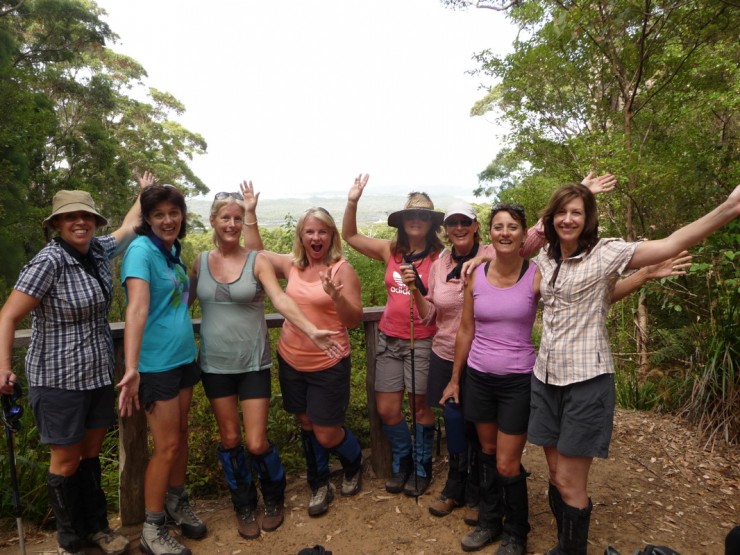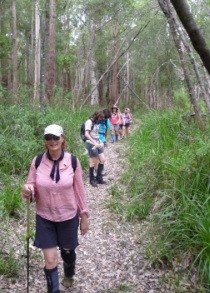Diary: Gaiter Girls go West on the Bibbulmun Track

Diary: Gaiter Girls go West on the Bibbulmun Track
Posted on
Simon and I recently had the pleasure of hosting eight Victorian women, the Gaiter Girls, on a walking holiday in the south west of WA. It was a great experience for us because we got to design the tour specifically for the group and show them our favourite sections of both the Bibbulmun Track and the Cape to Cape Track. We headed down to Denmark on Sunday straight from the airport. By the time we arrived in town it was late afternoon and the Gaiter Girls were ready for a walk -having spent many hours on a plane or in a bus that day. We chose the Mokare walk trail to start.
The Mokare Trail is an easy 3km walk trail that runs along both sides of the Denmark River between South Coast Highway and a former rail bridge at the river mouth. Views of the Wilson Inlet and the calm waters of the Denmark River; as well as smooth-barked karri trees, paperbarks and birds made the walk perfect for a relaxing afternoon stroll. Simon treated the girls to an interesting story about Mokare – probably the most well known Noongar figure from the south west area. Mokare was an excellent guide and interpreter for early settlers to the Albany and Denmark areas, and he had a genius for language and communication. These attributes led to his greatest triumphs, as well as his ostracism from the Minang people to whom he belonged. It was interesting to reflect on the life of this man as we walked through an area that he helped Europeans ‘discover’.
Day two was broken up into two sensational walks. For our first walk we started near the aptly named Cosy Corner and walked to Shelley Beach. It is an incredible walk – one I never tire of. The changes in vegetation along this section alone are enough to keep anyone interested; but with a backdrop including the rugged coast to the east (complete with giant rotating wind turbines) and crystal turquoise waters of Dingo Beach Cosy Corner, this walk has it all. Just as we were getting tired, hot and sweaty we descended to meet Simon on the beach where he was waiting with a sumptuous picnic lunch under the shade of a gazebo.
Lunch had to wait though – there was no stopping the Gaiter Girls from diving into the refreshing Southern Ocean. After recharging our batteries we all agreed that a short coastal walk was in order for the hot afternoon and headed for the Sandpatch windfarm where Simon put any Christian Scientist views at bay with his version of the formation of the earth.
The next day we only had about ten minutes to drive to the start of our walk… That didn’t mean we were early though, as coffees had to be ordered from the Bibbulmun Cafe – a proponent of the ‘slow coffee movement’- and gaiters had to be put on, and re put on. Simon and the group eventually got away and started the climb up Mt Hallowell in perfect cool conditions. The Girls found the walking relatively easy as the climb up the eastern side of Mt Hallowell is long but not too steep. There were some enormous boulders to marvel at and beautiful multicoloured karri trees, and the morning was punctuated with great views of Denmark and surrounds. Another refreshing swim at Lights Beach and a picnic lunch overlooking the ocean, and the girls set out for their walk to Greens Pool. By the time they got there they were all ready for another swim and oh what a swim it was.
Greens Pool, for anyone who hasn’t been, is a beautiful bay in William Bay National Park near Denmark. Granite boulders ring the pool and shelter it from waves – making it perfect for a relaxing swim. We swam, lazed on the rocks, walked to Elephant Cove and lazed some more before reluctantly tearing ourselves away for the evening. We consoled ourselves with an optional yoga session, some gin and tonics and an array of nibbles before dinner, so it wasn’t too hard.
Our final day in the Great Southern region was spent amongst the giant karri and tingle trees in Walpole-Nornalup National Park. The weather was heating up so the forest offered a cool relief. It was such a pleasure walking in the dappled light coming through the canopy above that we barely noticed the morning’s hills. Well, I noticed the hills, and I don’t know how much Pip was aware of the dappled light, but there were definately some fresh faces at our first stop at Hilltop Lookout so the forest must have worked its magic on some. Speaking of magic, there was a theory put forward by some of the Gaiter Girls that Enid Blighton’s Faraway Tree was in fact a tingle – a theory worth exploring I think.
Lunch was at the Valley of the Giants Tree Top Walk, where the girls also took the opportunity to get amongst the forest canopy on the 40 metre high suspended walkway. After lunch, with a general feeling of hill-phobia, we walked the best section of tingle forest on the Bibbulmun Track – definitely a contender for Enchanted Forest. “What hills?”, the Gaiter girls asked as we finished our walk, and I was glad to see that everyone had enjoyed our last walk in the region. But we still had one more for the holiday…
The next day we drove from Denmark to the Margaret River region. It’s not a short drive but we were at Contos by lunch-time and ready to walk one of the most spectacular sections of the Cape to Cape Track. Cliff-tops, pristine ocean views, limestone caverns and a wholly refreshing swim at Redgate Beach to end the walk made the trip worthwhile. We even treated some surfers to a half hidden strip show as we changed into our bathers behind the rocks. There was no time for change rooms though -we had wineries to visit!
Leeuwin Estate and Voyager barely knew what hit them as we sipped our way through buttery Chardonnays and fresh Rieslings. A stroll through the gardens of Voyager Estate is worth the drive out there even without their tastings – their formal garden beds were a change from the haphazardness of the bush. And that evening as we emerged fresh faced from our rooms at the Admiral Stirling we had also taken on a change – from gaiters and shorts to sandals and dresses – we all scrubbed up alright for our celebration dinner at Winos in Margaret River. A happy end to a fabulous tour of the Great Southern and Margaret River regions.




